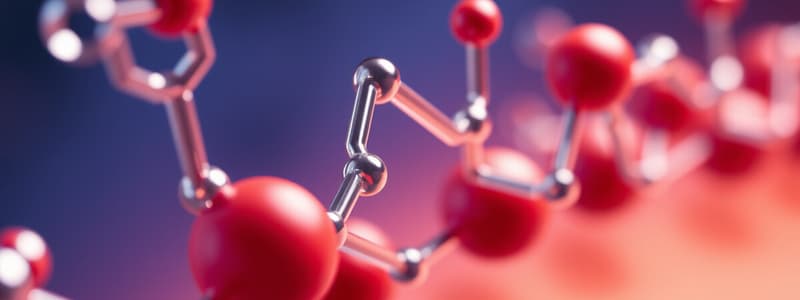Podcast
Questions and Answers
What are the four types of biological molecules?
What are the four types of biological molecules?
Carbohydrates, Lipids, Proteins, and Nucleic Acids
What is the main function of carbohydrates?
What is the main function of carbohydrates?
Stores chemical energy and durable building materials for biological construction
What is the structure of a simple sugar?
What is the structure of a simple sugar?
Chain of carbon atoms, each having a hydroxyl (-OH) group. Carbonyl group determines if ketose (ketone) or aldose (aldehyde)
What happens to sugars with 5 or more carbons?
What happens to sugars with 5 or more carbons?
How do sugars join one another?
How do sugars join one another?
What is a polysaccharide?
What is a polysaccharide?
What is glycogen?
What is glycogen?
What are oligosaccharides?
What are oligosaccharides?
What are three polysaccharides with identical sugar monomers but dramatically different properties?
What are three polysaccharides with identical sugar monomers but dramatically different properties?
What is starch?
What is starch?
What is cellulose?
What is cellulose?
What are the three types of lipids?
What are the three types of lipids?
What are fats?
What are fats?
What are triacylglycerols?
What are triacylglycerols?
What is a fatty acid?
What is a fatty acid?
What is amphipathic?
What is amphipathic?
What are saturated fatty acids?
What are saturated fatty acids?
What are unsaturated fatty acids?
What are unsaturated fatty acids?
What are oils?
What are oils?
What is specificity?
What is specificity?
What is a polypeptide chain?
What is a polypeptide chain?
What are peptide bonds?
What are peptide bonds?
Study Notes
Four Types of Biological Molecules
- Biological molecules include carbohydrates, lipids, proteins, and nucleic acids.
Carbohydrates
- Main functions: Store chemical energy and act as durable building materials.
- Simple sugar structure: Composed of a chain of carbon atoms with hydroxyl (-OH) groups; carbonyl group indicates if ketose (ketone) or aldose (aldehyde).
- Sugars with 5 or more carbons form closed ring structures through self-reaction.
- Sugars join by covalent glycosidic bonds between a carbon atom of one sugar and a hydroxyl group of another.
- Polysaccharide: Polymer of sugar units linked by glycosidic bonds.
- Glycogen: A highly branched glucose polymer, used as readily available energy in animal cells.
- Oligosaccharides: Short chains of sugars attached to lipids or proteins; crucial for cell differentiation and interactions.
- Three distinct polysaccharides with the same monomers:
- Glycogen (branched)
- Starch (helical)
- Cellulose (unbranched)
- Starch consists of two glucose polymers, amylose and amylopectin, used for energy storage in plants.
- Cellulose is an unbranched polymer with Beta(1→4) linkages, forming structural cables in plant cell walls.
Lipids
- Types of lipids include fats, steroids, and phospholipids.
- Fats are molecules with a glycerol backbone linked to three fatty acids, known as triacylglycerols.
- Triacylglycerols are essentially the same as fats, consisting of glycerol and three fatty acids.
- Fatty acids are long, unbranched chains with a single carboxylic acid group at one end.
- Amphipathic molecules have both hydrophobic and hydrophilic regions, crucial for biological functions.
- Saturated fatty acids lack double bonds between carbons, while unsaturated fatty acids contain one or more double bonds.
- Oils are classified as fats that remain liquid at room temperature.
Proteins
- Specificity refers to selective interactions among cell components, vital for life.
- Polypeptide chains are long, continuous polymers formed from amino acids linked by covalent peptide bonds.
- Peptide bonds connect amino acids in a protein, forming when a carboxyl group of one amino acid reacts with the amino group of another.
Studying That Suits You
Use AI to generate personalized quizzes and flashcards to suit your learning preferences.
Description
Test your knowledge on the four types of biological molecules through these flashcards. The quiz covers key concepts such as the functions of carbohydrates, the structure of simple sugars, and more. Ideal for biology students looking to reinforce their understanding.




